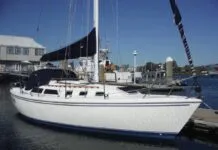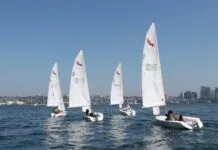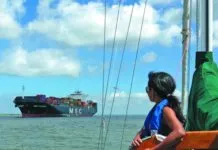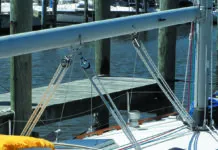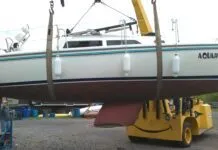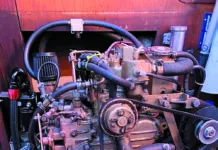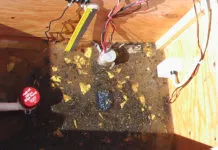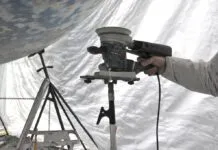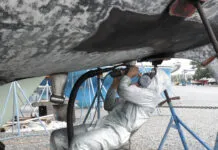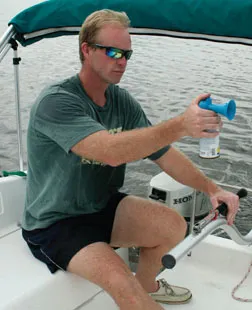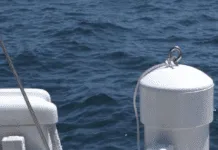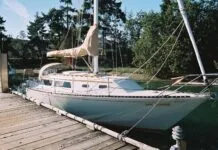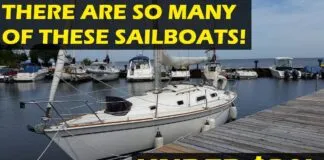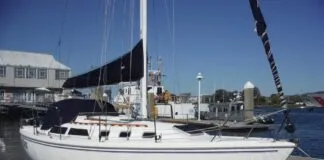Among inexpensive sound signal devices, gas-powered horns are hard to beat-and darn near all the same. Whistles are better left clipped to life jackets, as Practical Sailor found out in our last test, published Sept. 1, 2002.

Collisions are among the most devastating problems that can occur at sea. Collision avoidance is the fundamental rationale for keeping a watch. An aid to the human eye is radar, which has line-of-sight range to the horizon, and even can “see” through fog and the darkness of night. Other devices include the CARD (collision avoidance radar detector), which alerts you, on your small boat, that a vessel with radar is around.
Some of the U.S. Coast Guard regulations are specifically intended to promote collision avoidance and contain yet additional methods, namely sound.
Sound signals had a much better chance of being heard during the age of sail, before the invention of the steam and internal combustion engines, the loud racket of which makes it hard to hear a ships bell pealing through the fog. But a loud warning or distress sound is better than no sound, so the regulation still stands.
The Coast Guard requires boats up to 39 feet, 4 inches (12 meters) to carry a whistle or other sound device capable of making an efficient sound in short blasts of one second and long blasts from four-six seconds. No bell is required if the above requirement is satisfied. Boats up to 65 feet (20 meters) must carry a whistle or other sound-making device audible for at least a half-mile, plus a bell with a mouth diameter of at least 7.9 inches.
American Boat and Yacht Council (ABYC) standards are essentially the same, but are more specific as to frequency and materials. For example, for vessels 16.5 to 39 feet, “The horn/whistle shall have a fundamental frequency between 250-1750 Hz and shall be capable of producing sound at the equivalent of 105 dB (A) at 1 meter (3.28 feet) from the sound source at an ambient temperature of 25C /- 5.5C (77F) within an intermittent time cycle of six seconds on, two seconds off, six seconds on, 106 seconds off, for a period of eight hours. The basic power source may be replaced.”
The last statement is an attention-getter: eight hours! That means the horn has to sound 48 minutes during that period. We didnt follow this regimen for eight hours to see how long a 5.5- or 8-ounce canister of gas would actually last, but we suspect strongly that they wont last nearly that long. This makes a good case for carrying several refill canisters. Nor is it likely you would want to keep up this regimen for eight hours blowing into a lung-powered horn or whistle. The suggested alternative then is an electrically powered horn, and in addition to gas horns and ordinary whistles, we tested one of those, albeit a small 9-volt DC model.
Products Tested
For this test, Practical Sailor testers purchased 13 signal devices: four gas-powered horns, two rechargeable air-powered horns, one battery-powered horn, five lung-powered whistles (blow hard!), and one lung-powered horn (blow harder!).
Some are the same as those tested in the 2002 test of handheld signals, some are new.
Gas-powered Horns
Falcon seems to be the dominant force in gas-powered horns. We tested two of its products-the Push Button and Sports models. It also makes the Signal Horn for West Marine, which appears identical to the Falcon Sports model, except the West Marine horn is sold with a red plastic trumpet instead of an orange one, and it has more propellant. The Push Button model and the Tempo Safe & Sound also have more propellant, which accounts for their higher prices.
The propellant in the Falcon Push Button, West Marine Signal, and Tempo Safe & Sound horns is tetrafluoroethane, a refrigerant that is said not to harm the ozone layer (the diminution of which has been linked to global warming). Inhalation of the chemical, however, can be fatal, so the canisters have warnings to “Keep out of reach of children,” and not to “deliberately concentrate” the propellant or to puncture the canister. Tetrafluoroethane is said to be non-flammable, but because it is a refrigerant, spraying it onto the skin may cause frostbite.
The Falcon Sports propellant is isobutane, also claimed not to harm the ozone layer, but it is flammable. The can label warns against smoking near the horn, or allowing it near flames or high heat. The same warnings about children and inhalation apply.
Curiously, in a country with more than 30 million Hispanics, labels on these devices are printed in only English and French! Comprendez? (West Marine explained that this is to satisfy Canadian packaging regulations.)
Tempo Safe & Sound. Chrome trumpet is made in Taiwan; 8 ounces of propellant; no country of manufacture listed, though the packaging and labels say, “Printed in USA” (which sounds like a way to conceal the cans origin).
Falcon Sports. Orange plastic trumpet; made in USA; 5.5 ounces of propellant. In our tests, the canister proved defective-why we don’t know, but there was plenty of gas remaining inside. To complete the tests, we used a refill canister.
Falcon Push Button. Chrome trumpet; made in USA; 8 ounces of propellant. The other three are actuated by push-buttons, too, so the name of this horn is no big deal. Falcon guarantees that sound from their horns will travel “up to 1 mile over land or sea.” We don’t know about land, but it was audible for 1 mile over water.
West Marine Signal. Red plastic trumpet; 8 ounces of propellant; pretty much the same as the others, right down to the French name-Sirne de signal.
Rechargeable Air-powered Horns
The advantages of these devices are fairly obvious: You never have to buy refills, and there are no gases to worry about-if not for the ozone, then for your own sinuses and brain cells. The downside is that you have to pump manually to fill the canister. The pumps that came with our two devices are identical, labeled EcoBlast Hi-Pressure Mini Pump. Theyre made of a black plastic and look like small bicycle pumps. A lever locks the end onto the inflation valve. In lieu of the provided pump, a bicycle pump or an air compressor also may be used-but if the latter, beware of exceeding the canisters pressure limits: 150 psi for the Taylor Made EcoBlast and 80 psi for the West Marine EcoHorn.
Taylor Made EcoBlast. The air canister is made of aluminum and is about the same size as those found with the gas-powered horns. The trumpet is black ABS plastic, permanently affixed, with a yellow push-button to activate. Its made in Canada. There are no instructions and no indication of how many manual pumps it would take to come close to 150 psi. We pumped 60 times, at which point we met fair resistance.
In our tests, this horn barely had any wind left at the end of the six-second prolonged blast test. In the range test, it did pretty well, earning Goods until the 1-mile mark where it dropped to a Fair.
West Marine EcoHorn. The pump is the same one that comes with the Taylor Made EcoBlast, but there the similarity ends. The canister is clear plastic fit into a red cloth cozy. The black plastic trumpet looks like a French horn-its cute. Theres a volume control, which is unique to the horns tested. At 80 psi (maximum recommended), the label says it yields “over 50 half-second blasts.” Actually, it depends on the volume: up to 70 at minimum volume, and just 30-40 at maximum. Keep in mind that these are mere half-second blasts; the ABYC standard calls for intermittent blasts of six seconds.
Like the EcoBlast, this horn barely blew for six seconds and was not very loud at the end. In the range test, as distance increased, its performance fell off more quickly than that of the EcoBlast. All testers agreed it wasnt as loud as its competitor.
Battery-powered Horns
The ABYC standard for sound signal devices was developed mostly with electric horns in mind, the kind commonly found on larger powerboats and motoryachts. In our group of portable products, just one is electric, and battery-powered at that.
Innovative Lighting. This 8-ounce, handheld horn emits a banshee-like screech that sounds quite different from the blat of gas-powered horns. The grip is comfortable, and the trigger easily actuated. Power is a 9-volt battery, so theres no gas involved. It comes with a mounting cradle that can be screwed to a bulkhead or other surface. Its made in China, and comes with a five-year warranty. The price varies from $25 at Boaters World to $33 at West Marine online (to $80 in the 2006 West Marine catalog, which must be a mistake).
This horn makes an unpleasant sound, not that any horn or whistle is actually pleasing to the ear, but this one is, well, electronic and strange. Its strong suit is that it doesn’t get tired or depend on pressure for peak performance. Over time, voltage drop will diminish performance, but thats not an issue in the short term. The loudness of its signal, however, is not in the same league as the gas-powered horns, or even our top-rated whistle. As distance increased in the range test, performance fell off; the signal was just audible at a quarter-mile.
Lung-powered Horns
Any device you blow into to actuate is going to be environmentally safe, infinitely reusable, and limited in duration only by your lung capacity. While some of these horns are loud enough, none can sustain that max level for six seconds, at least not with the lung power of our testers. Two to three seconds was typical.
Marine Safety Blaster Horn. From the same folks who bring you flares and other safety signals, the Orion Marine Safety Blaster Horn is about 10 inches long and just less than 3 inches in diameter. Its made of orange plastic and has a 24-inch lanyard for hanging it around your neck or elsewhere. The packaging claims 120 decibels and a range “over a mile away.” With our testers lungs, that proved to be a joke; we couldnt hear it at a half-mile. The Blaster Horn is made in China.
Lung-powered Whistles
Whistles can satisfy USCG requirements if theyre loud enough. Not all are. Each of the five we tested is an inexpensive red or orange plastic device that comes with a ring or lanyard. They are easily pocketed or clipped to life jackets, which we think is a better use for these than as a primary vessel signaling device.
Why? Because its hard to blow on any one of these-with loud results anyway-for six seconds. We think thats a major shortcoming.
Acme Marine Water Sports Whistle. Acme says its been around since 1870. The packaging claims this whistle is SOLAS approved and is used by the U.S. Coast Guard, NATO forces, and the Mountain Rescue Association. It also is said to have both “high frequencies that cut through background noise and low frequencies to penetrate further and carry over distance.” To us, and a blind dog lounging nearby, it just sounded shrill-as it should. Made in England. On the Boaters World website, its sold as the Orion Tornado. It and the ACR Res-Q tied for second in the whistle category.
ACR Res-Q. ACR is a U.S. company that specializes in safety equipment, including man-overboard gear. The whistles packaging says the Res-Q whistle was developed for the U.S. Navy and is used by NASA. The company claims a “pea-less” dual tone at 102 decibels (the pea is the little ball inside some whistles that helps create sound). In an emergency, it recommends issuing three short blasts, three long and three short, with the long blasts being three times longer than the short blasts (Morse code for SOS). Made in China. Not as loud at 1 meter as the Acme or Orion, but sound carried as far.
All Weather Storm Safety.Packaging warns repeatedly that the Storm is “extremely loud,” and that hearing loss can result. It recommends wearing ear plugs. Made in the U.S. West Marine private labels this whistle. Its probably one of the few sound signals that have been displayed at the Museum of Modern Art in New York for its artistic value. The whistles maker describes it as looking like a “pregnant seahorse.” As in the last test, the Storm was far and away the loudest whistle, and audible at the greatest distance: a half-mile.
USS Value Whistle 911. Marketed as a survival aid on land and water, this whistle also is billed as a crime deterrent. It claims sound “up to 118 decibels.” There are two chambers for multiple pitches; the design is intended to produce a fluctuating tone that pierces background noise. Flanges on the mouthpiece allow users to maintain a lip seal in cold air and water despite chattering teeth or stiff lips. (The Storm has this feature, too.) Made in the U.S. In our test, this whistle was the quietest of the lot-just 100 decibels at 1 meter.
West Marine Safety Whistle.These come two to a pack and sell for $10. Made in Taiwan, they are very similar in design to the ACR, and just as loud at 1 meter, but not impressive at a distance. Like the others, its best clipped to a life jacket, not relied on as a vessels primary sound signal.
Bottom Line
Testers agreed that for a large boat, wed buy an electric dual-trumpet horn and make our signals with 12-volt power. Thats because none of the devices we tested is ideal.
The four gas-powered horns tested all performed the same. Each pegged the decibel meter at 126. And why wouldnt they? After all, the trumpet designs appear virtually identical, and three of the four use the same gas propellant. Were hesitant to add another combustible to our boat, so the Falcon Sport is out. If you think the chrome-plated trumpets last longer or look better, spend the few extra bucks. At the end of the day, the Falcon Push Button gets our recommendation, but really theres little difference between it, the Tempo, and the West Marine.
The rechargeable air-powered horns were louder and more audible at greater distances than we expected. The only problem is users must pump them up between blasts, and you certainly couldnt do 60 strokes in the two-second interval ABYC specifies. Wed consider buying the Taylor Made EcoBlast only as a backup. The West Marine EcoHorn wasnt as loud.
Among whistles, the Storm was the winner, but even it is better suited to a life jacket than as a primary signal device, though in a pinch, it would certainly be better than screaming at the top of your lungs.
Contacts
Acme, 44 (0) 121 554 2124
ACR, 954/981-3333, www.acrelectronics.com/
All-Weather Storm Whistle, 877/261-3897, 314/436-3332, www.stormwhistles.com/
Falcon Safety Products, 908/707-4900, www.falconsafety.com/
Innovative Lighting, 515/388-1011, www.innovativelight.com/
Orion Safety Products, 800/851-5260, www.orionsignals.com/
Taylor Made, 518/725-06781, www.taylormadegroup.com/
Tempo Products, 800/321-6301, www.tempoproducts.com/
USS Value Whistle 911, 800/750-6583, www.ussvalueproducts.com/
West Marine, 800/685-4838, www.westmarine.com/


